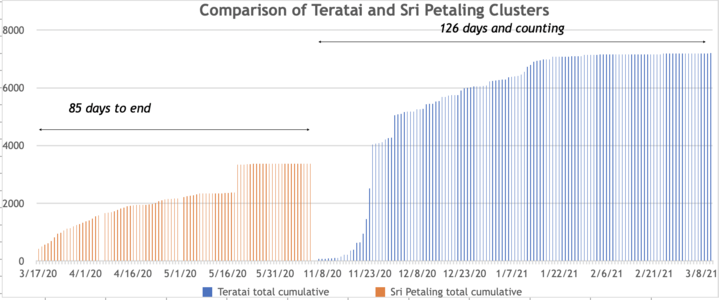KUALA LUMPUR, March 12 — Last November 6, a Covid-19 outbreak was reported among factory workers of a rubber glove manufacturer in Selangor, and 126 days later, this cluster remains active and has registered 7,198 cases.
This cluster linked to Top Glove Corporation Berhad, known as the Teratai cluster, currently has 78 active cases, 7,119 recoveries, and saw one death as of March 11. One new Covid-19 case in the Teratai cluster was reported yesterday.
Before the Teratai cluster, the Sri Petaling cluster, or commonly known as the Tabligh cluster, was the biggest cluster in the country that took 85 days to end after infecting 3,375 people. The Tabligh cluster was active between March 17 and June 11 last year.
The Tabligh cluster initially started during a religious event that took place in Seri Petaling, Kuala Lumpur, with 16,000 attendees. Following the event, Covid-19 cases from this cluster were detected in most of the states in Malaysia, including Sabah and Sarawak.
However, the Teratai cluster is mostly confined to Top Glove factories in Meru, Klang, and has only spread to Negeri Sembilan and Terengganu, besides the Klang Valley.
As of March 11, Teratai has reported 7,198 Covid-19 cases out of 10,400 people screened, an extremely high positive rate of 69.2 per cent. Four months on, health authorities still did not yet manage to test every single one of some 13,000 workers from 28 Top Glove factories in Klang. The 28 factories were put under a four-week lockdown, running from November to December 2020.
It is unclear if all the 10,400 people screened so far are factory workers, as Health director-general Dr Noor Hisham Abdullah previously said last December 2 that the Teratai cluster had spread to the community.
Initially, between November 6, 2020 and February 10 this year, Covid-19 screening was done almost every day in that cluster until February 6 this year.
The highest number of daily screening was done on November 22, whereby 4,685 tests were conducted and 504 new daily cases were reported on the same day, which showed a positive rate of 10.8 per cent.
The second highest number of screening was then done on December 11, 2020, when 1,681 tests were conducted and 128 cases were registered, translating to a positive rate of 7.6 per cent.
Then, after February 11, the number of tests conducted dropped to below 20 every day until March 11. On some days, no screening was done at all. However, the number of positive cases detected were equal to the number of tests conducted on that day.
For example, on February 11 and February 21, one test was conducted and one case was detected. On February 22 and February 23, four tests were conducted each day and four cases were detected. Similarly, on February 24, 18 tests were conducted and 18 cases were detected, all translating to a positive rate of 100 per cent.
A positive rate above five per cent simply means that there are more undetected cases within the community and more tests should be conducted.
An anonymous medical practitioner explained that one of the possible reasons why the Teratai cluster has a very high positive rate is because at one point, due to overwhelming cases in Selangor, the Ministry of Health (MOH) only tested symptomatic close contacts of positive cases.
“You should not only test the symptomatic cases, test the asymptomatic ones because these are the ones who are going about spreading,” the anonymous medical practitioner told CodeBlue today.
“That is the problem, that is why the Teratai cluster is not going to die for me at least for another month, minimum.”
However, on February 17, MOH said that they are testing all close contacts and not just symptomatic ones, reversing the earlier circular on only screening those with Covid-19 symptoms.
Another reason why the doctor said that the Teratai cluster has a higher number of cases compared to the Tabligh cluster is that the Teratai cluster is confined to one locality.
“This one is a locality cluster. Meaning, it’s in one place and they are not moving anywhere much. Meaning around that area but within the factory itself.”
On top of that, during the outbreak among factory workers in Top Glove, Human Resource Minister M Saravanan, who visited the workers’ dormitories, said that the dorms were crowded and unsanitary. These conditions could only foster the spread of Covid-19.
The medical practitioner also said for this cluster, a one-time screening for each individual wouldn’t suffice to end the cluster.
“When we do that, these workers are moving, they go outside, they go and meet people and come back. Today, they get tested, they go out, they meet someone, five days later they are positive again.”
Hence, the doctor stressed the importance of using the Prevention Of Outbreak and Industry Sites (POIS) system, as implemented by the Selangor Task Force for Covid-19 (STFC).
The doctor explained that by using this system, employees from the Top Glove factory who are linked to this cluster can be screened periodically every two weeks, in order to quickly detect and isolate positive cases.
As most of the Covid-19 cases from the Teratai cluster involved foreign workers, the doctor said that this was another lesson to show the importance of immunising all foreign workers with the Covid-19 vaccine.








